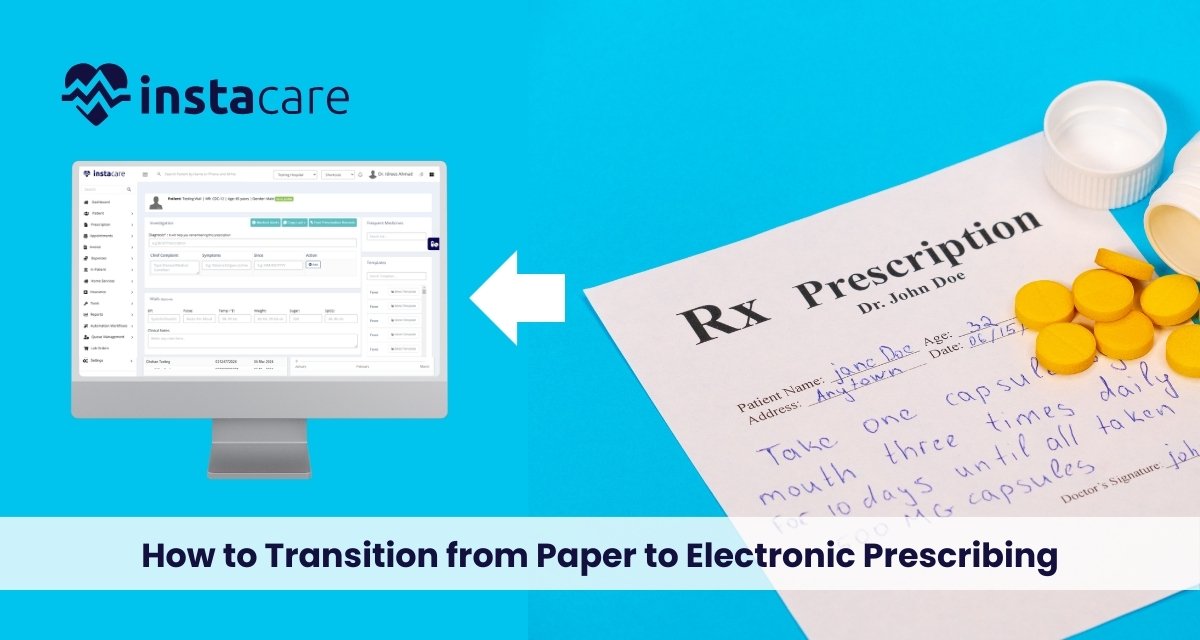Last updated on Wednesday, 19, November, 2025
Changing to e-prescribing is a revolutionary step for the health providers in changing from paper. It is one of the techniques that make workflow streamlined, make it safe to patients, and improve efficiency in the delivery of health care. A careful plan and execution will help smoothen the process. This guide gives an all-out step-by-step way of accomplishing this efficiently.
Table of Contents
Introduction to E-Prescribing
E-prescribing is an electronic write, transmit and refill of script of a prescription. The same communications technology enables health care providers to transmit prescriptions electronically and electronically signed prescription order forms to the pharmacy. It is also important to appreciate the fact which is inexistence in paper prescriptions; e-prescribing is intended to bring out more precision, interaction and coordinating of medication dispensation.
Why Transition to E-Prescribing?
- E-prescribing reduces the chances of errors due to illegible prescriptions and informs against drug interaction and allergy, which means safe medication.
- Efficiency: E-prescribing eliminates the lost time in paper prescriptions. It also hastens the prescription as patients are given care timely.
- Better Communication: The direct communication between providers and pharmacies minimizes probable differences and delay in filling up the prescription.
- Compliance Rules: Healthcare rules and insurance demands are moving toward electronic prescription. The practice has to cope up with this change.
Step 1: Review Your Present Process
First and foremost, before arriving at an e-prescription, it is very important to look at the present process.
Review Present Processes
Identify Pain Points: Assess your paper-based prescribing process. Determine the issues associated with your process, such as prescription errors, delayed pharmacy communication, and time used in paperwork.
Gather Feedback: Discuss with pharmacists, physicians, and administrative staff. They can give insights on where your system lacks in areas that are essential to change.
Analyze Software Requirements
Define Requirements: Define what functionality an e-prescribing system should possess. A few of the functionalities required include drug interaction check, alerting allergies, a refill manager, and connectivity with EHRs.
Budget Implications: Establish the cost implications of e-prescribing systems, such as buying and implementing, training, and sustaining the system at large.
Step 2: Selecting the Best Electronic-Prescribing Software
Choosing the right e-prescribing software is very elementary to a seamless transition.
Alternative Research
- Compare Companies: Compare various available e-prescribing systems in the market. Identify the vendors that have a robust feature that meets your practice’s needs.
- Asses Compatibility: Insure the tool is compatible to your existing electronic health record or EHR application otherwise it will conflict or trigger workflow.
Compatible can improve workflows and data much more.
Assess Features
- User Interface Easy: Make software user-friendly whereby the system is to be maneuvered easily by one of the employees; this enables quick adoption without a long learning curve.
- Help and Training Support: The implementing vendor should support your staff well with proper training ensuring that technical matters that might emanate during this process are worked out.
Step 3: Preparation for Implementation
Good planning entails a smooth takeoff.
Timeframe
Establishing Milestones: The implementation setup stages might involve testing, training, and full deployment. Set deadlines for every phase to ensure that the project remains on course.
Resource Allocation: Determine human and financial resources required for transition. Ensure there is enough resources in place to counter any challenge.
Preparing the Staff
Training Sessions: Schedule complete training to all the users. It will include physicians, nurses, and administration staff. The training must cover navigating through the system, prescription entry, and management of patient information.
Step 4: Identify Champions:
Find out the most techie staff and make them champions to help people while transitioning. Champions can be approached for any query or help and can reduce the learning curve.
Test the System
Testing is required before the complete deployment of the Electronic-prescribing system.
Pilot Tests
- Small Scale Implementation: You would implement the e-prescribing system small scale with fewer populations and test whether that system could harbor problems which may emerge prior to mass adoption.
- Channel for Feedback: You would maybe allow an official process by which feedback was received from end-users within the pilots. Feedback through patients would indeed prove very effective at changes and revisions made within the system itself, as well as to patients’ workflow
Analyze the Issues
Technical Errors: These can be troubleshooter- resolved technical errors when encountered in a pilot test. Allow users the bug filing functionality while providing immediate response.
Workflow Changes: Changes in workflows will be made based on user feedback to improve business efficiency and usability. This could be in terms of streamlining the workflow or redistributing tasks to fit the new workflows better.
Step 5: Full Deployment
This is when the e-prescribing system should go live, now that testing has been completed successfully.
- Launch the System: Roll out the full e-prescribing once testing is successful and any necessary adjustments are made. Share the launch date with employees who then prepare.
- Monitor Performance: Monitor performance of the system as issues are addressed promptly. Monitor prescription errors, user engagement, and general uptake of the new system.
Continued Education
Train the user on new things and best practices in the tools. Ongoing training will help create a culture of lifelong learning and adaptation.
- Listen to Users: Always be open to listening to feedback from users or other users who have issues or improvements to be made in such an application. Ongoing feedback keeps abreast of the ongoing issues and areas for enhancement.
Step 6: Evaluation and Optimization
Once the Electronic-prescribing application is implemented in the system, its impact should be evaluated for its optimization in further utilization.
Outcome Measurement
- Track Measures: The key measures of performance regarding prescribing errors and time savings together with user acceptance be tracked. Effect on overall efficiency of practice related to patient safety of the e-prescribing system be measured.
- Seek the Views: Organize regular staff meetings to solicit perceptions about the experience of e-prescribing. Perceptions will form a very key basis for future development.
- State of the Art Improvement: Stay alert about latest software upgrade as well as introduction of new functionalities that can benefit the system function. Check upon the system often in a bid to upgrade it to contemporary needs of practice.
- Improve Processes: Change work flows if need arises to be both efficient and safe. Routine checks on changes to processes need to be implemented so that relevance to the practice’s and their patients’ changing needs is achieved.
FAQs
Benefits of E-prescribing vs Paper Prescription
E-prescription offers the following advantages over others
Less Error: No scope of misinterpretation due to shabby handwriting
Immediate Alerts: Enables real time drug interaction as well as allergic alerts.
Quick Communication: This will help to facilitate fast communication between the providers and pharmacies, and patients will not have to wait for so long.
How long, on average, does it take for an implementation to go live with e-prescribing?
The transition timeline is quite general and depends on the size of the practice and the type of software being used. Generally speaking, it would take the practice weeks or months for a transition. It has to undergo phases of planning, training, and testing that are conducted prior to the actual rollout.
What if my staff doesn’t want change?
Resistance to change is the most prominent phenomenon that may occur in any organization. For allaying concern of staff regarding change:
Diligent Training: Make sure that everyone who is a user feels absolutely confident about this new system.
- Benefits: This would include the potential benefits of improved patient safety and high efficiency of this e-prescription system.
- Involve Staff: Discuss change with the employees; get their response regarding the transformation as this creates a feeling of participation.
Conclusion
Paper to Electronic Prescribing reduces the practice from being cumbersome with time. Going through this is easy if practitioners use this comprehensive guide. A step-by-step guide would easily take health providers on this transition by ensuring both patient and staff’s benefit in these new electronic modes. It would go beyond the basic improvement in prescription practices, toward making healthcare much safer and even more efficient as a whole. Only with embrace, proper investments in proper education, and unrelenting drive to constant evaluations and optimization may long-term e-prescribing successes be expected.



